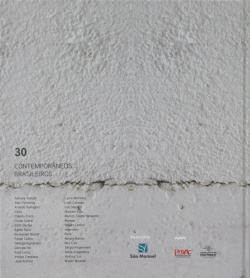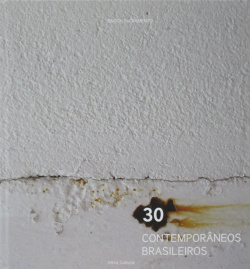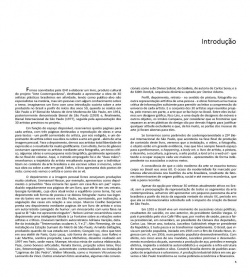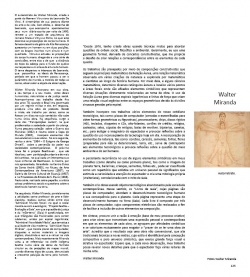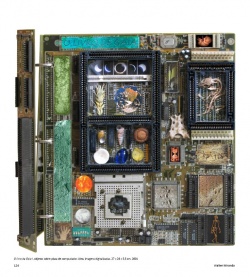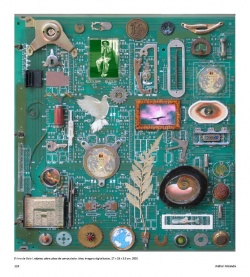#img_1621#
Introduction
We were invited by ID4! to prepare a book, a cultural product of the “Contemporary Art” project, intended to present the work of 30 Brazilian plastic artists in activity, having as target audience not specialists in the matter, but people with some knowledge on the subject. We imagined a book with a succinct introduction to the art produced in Brazil from the early 1950s, when the 1st Biennial of the Museum of Modern Art of São Paulo takes place in São Paulo, in 1951, later called Bienal de São Paulo (1959) and, finally, the International Biennial of São Paulo (1977), followed by the presentation of the 30 artists foreseen in the project. Depending on the space available, we reserve four pages for each artist, with three pages for the reproduction of works and one for texts - a commented profile of the artist, written by us, and a statement by the artist about his work or about art in general - in addition to a personal image. For the testimony, we gave the artists total freedom of expression and the result was very gratifying.
In effect, books of the genre usually present the artists through a photograph, a critical text, some works and a small biographical note, usually presented at the end of the volume. Here, the method used was “two hands”: we review the artist's trajectory, highlighting aspects that individualize him in the context of Brazilian art and he writes about himself, about his work or about art in general.
Finally, the book presents two points of view: how we see the artist and how he sees himself. The free testimony and personal image gave rise to very creative productions. Emmanuel Nassar, for example, presented as a testimony the proverb “Good pilgrimage makes those at home stay at peace” reproduced repeatedly in the pages of a book, which he reads in his portrait. Georgia Kyriakakis, whose current work includes balance as a theme, makes a statement in the form of poetry and allowed herself to be photographed on a steep street in the neighborhood where she lives in São Paulo, accentuating, by inclination, the angulation of the houses in relation to her body. Marcos Coelho Benjamim gives his testimony through pages of an artist's book and created a self-portrait full of humor: a rhinoceros with a banner that reads “don't introduce me to anyone”. Nelson Leirner sent a testimony to an intelligent fable to La Fontaine about the relationship between artists and critics. They also sent self-portraits Adriana Varejão, detail of the installation “Eyewitnesses X, Y and Z”; Alex Flemming, from his installation at the São Paulo Metro Sumaré Station; Arnaldo Battaglini, produced when he was in London; Gonçalo Ivo, a work he has in his Paris studio; Guto Lacaz, in the form of a logo; Jose Rufino and Luiz Martins, cast shadow; Laura Michelino, drawing done in 1997 in Paris, where she lives; Marepe, mixed technique of curious elaboration; Paze, as an articulated doll; Renata Barros, projection on latex; Rico Lins, photomontage; Vinicius, self-portrait contextualized in the installation “Lágrimas de São Pedro”, Walter Miranda, as Leonardo da Vinci's Vitruvian Man. Others sent signed photos, some unconventional ones such as Divino Sobral, from Goiânia, by Carlos Sena; and that of Edith Derdyk, a dynamic sequence captured by Denise Adams. Profile, testimony, portrait - in the sense of painting, photography or other artistic representation of a person - and works form a critical mass of information sufficient to allow the reader to understand the universe of each artist. And the group of 30 artists gathered here projects, at least in part, the art that is made today in Brazil. Among them we include a graphic designer, Rico Lins, and a pair of designers of furniture and other objects, the Campana Brothers, considering that the borders that separate the visual arts from design are too fragile to justify any exclusionary attitude and that, the doors of art museums have long been opened for them. If we take the 29th Bienal Internacional de São Paulo as a contemporary parameter, which took place in the final stage of content production for this book, we will see that the installation, the video, the photograph, the object are in great evidence, but that there is and always will be space for performance, happening, body art, artist's book, painting, drawing, sculpture, printmaking, postal art, land art and web art - which tends to occupy increasingly larger spaces - presented independently or associated with other means. The awareness that the modern art cycle was exhausted took shape in Brazil in the 1960s. The decline of modernity was marked by an intense effervescence in the bastions of Brazilian art, resulting from determining factors of political, social and even economic origin, which it is worth remembering. Despite the option to list 30 artists currently active in Brazil, without the concern of representing all segments of contemporary art, we find useful to present a small overview of Brazilian art from the beginning of the second half of the 20th century, a period in which it internationalizes mainly under the impact of the creation of the São Paulo Biennial. In 1955 Brazil is going through a period of successive political crises, resulting from the suicide, in the previous year, of President Getúlio Vargas. The country is chaired by Vice Café Filho who, for health reasons, passes the presidential sash in November to the president of the Chamber of Deputies, Carlos Luz. However, that year, Juscelino Kubistchek is elected president of the Republic. And everything starts to change quickly. Brazil, which was going through a populist period, started in 1945 with the end of the Estado Novo, entered with JK, in 1956, in a populist-development period. Indeed, in the five years of his mandate, Juscelino promotes the economic development of the country, increases the production of steel, oil and electricity, deploys the automobile industry and expands the transport infrastructure, warehouses and silos. Build Brasilia within advanced standards of architecture and urbanism. Industrial production doubled under his government and São Paulo became an economic and financial power.
Walter Miranda Walter Miranda's self-portrait, created from Leonardo Da Vinci's Vitruvian Man, is symptomatic of his attitude towards art and life. Indeed, Leonardo's drawing, which accompanies his notes in a diary written around 1490, refers to an architectural treatise by the Roman Marcus Vitruvius Pollio, in which he describes the proportions of the human body. The famous drawing of the genius of the High Renaissance features a naked man in two positions, with his arms inscribed in a circle and a square. Vitruvius studied the proportions of the human body, reaching a series of conclusions, among them that the distance from the top of the head to the bottom of the chin corresponds to an eighth of the man's height. The theme aroused Leonardo's interest, who embodies the ideals of the Renaissance, a period in which man became the parameter of the world, the measure of all things, observer and object of observation. Walter Miranda incorporates these humanist, naturalistic and social justice ideals into his work, in his time and in his own way. We have been following his work since the late 1970s, when Brazil was governed by a military regime and he, in response, produced a protest work. From the beginning, he works in series, as if giving a speech whose content does not fit in a single work. In the sequence, there is the series of “Social Transpositions”, in which society is problematized from the perspective of children. In a small collection on the Malvinas War (1982) and another on the World Cup (1983), he incorporates unconventional elements into his works.
In the following year, he made the series “1984 - The Stigma of George Orwell”, about the perversion of power in contemporary societies. The next move was the Beethoven Project, which he devised, with his own participation and that of two more artists, in which each performed Beethoven's nine symphonies. The exhibition, presented by us, was shown at the Centro Civico de Santo André (1985), at the Museum of Contemporary Art of Americana (1987), at the Gallery of the Centro Cultural de Guarujá (1987) and at the Pinacoteca do Estado de S. Paulo (1988). In this series, carried out on cardboard, the artist poses social problems and questions about the fate of man on earth. In the sequence, Walter Miranda, in addition to activities as an art teacher and class leader, made other series, among them "Brave New World", in which the social mixes with the ecological; “Seattle Project - Exaltation to Gaia”, in which the question of justice and the “mother-earth” (Gaia) is deepened, in which triangles are divided to contain subthemes, united by logarithmic spiral; “Brave New Middle Ages”, which addresses the modern quality of life; “Brave New Millennium”, which mixes computer boards, diskettes and other materials with digital images, discussing the real and the virtual in contemporary life. More recently, Miranda again referred to the Seattle indigenous chief in a series of circular-shaped works or projections of world maps, using various types of scrap metal, denouncing the growing pollution of the land by man.
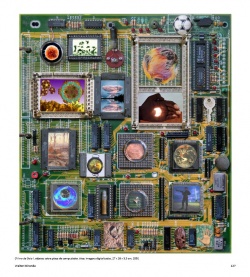
Livro de Gaia I
Walter Miranda by Walter Miranda “Since 1976, I have created works using mixed techniques to address social, philosophical and environmental issues. Generally, I use formal geometry, derived from constructivist concepts, which gives me the challenge of creating relationships and correspondences between the elements of each painting. The works are planned through constructivist compositions that follow the mathematical principles of the Golden Relationship, a mathematical relationship observed in various creations of nature and explored by mathematicians and scientists throughout human history. Through it, and some mathematical calculations, I determine several golden rectangles and locate several focal points and areas where symbolic elements are displayed that represent various situations directly related to the theme of the work. The use of the Golden Ratio generates several logarithmic spirals and lines of force that create an organic visual relationship between geometric spaces due to the sinuous divisions generated by the spiral. I also incorporate in my work various elements of our technological daily life, such as: computer boards (sawn and ground to obtain geometric or figurative shapes), processors, chips, hard drives (HD), keyboards, diskettes and CDs, speakers, credit cards, watches, padlocks, stamps, watch domes, revolver bullets, jewelry, pens, etc.; to instigate the spectator's imagination and provoke reflections on the question of the inconsequential use of technology today. The incorporation of elements of nature, such as: shells, snails, seeds, leaves, flowers (prepared to not deteriorate), earth, etc., serves as a counterpoint to the technological elements and provokes reflections on the issue of the environment and human being. The persistent recurrence in the use of some symbolic elements in my works (as a detail or as a foreground), such as the image of the planet Earth, ballerinas, children, seeds, leaves etc., can be classified as a repertoire that emphasizes a personal universe of meanings that stimulates the viewer's curiosity and attention and creates a mythology of its own (Walterian), correlated with the myth of Gaia. I also create works using technological objects abandoned by contemporary society. In this sense, the “Gaia’s book”, whose pages are computer boards, address human technological development and its consequence for the planet. Each page represents a stage of human development on Earth (Gaia). Each book consists of three computer boards, whose electronic components are relocated in order to facilitate the inclusion of other elements in the composition. In summary, I try to combine reason with emotion (the basis of my creative process) to create works that convey a personal and contemporary expression in which the elements of each work are grouped by symbolic affinities and value each other to rescue the “pleasure of reading a work of art ”. I believe that the result is an unconventional work, which combines traditional techniques with new media, whose style is identifiable by the compositional conception and the symbolic universe, which exerts great visual and attractive force on the viewer. I hope that, with each new observation, my work can reveal new details for the viewer to make several readings of my Art.
